What you need:
- Wire: Any of the following work.
- Coat Hanger: For a lot of people, this will be the only wire they have without having to go out and buy something. The thick ones can be a little hard to bend, so use the thinnest one you can find. You will need pliers to bend it again and again in the same place until it breaks. This is called metal "fatigue." You need about a 12" piece.
- Utility wire: Small, inexpensive rolls of solid steel, copper and aluminum wire are available from building centers and hardware stores. Thickness is denoted by a gauge number for maximum confusion. The bigger the gauge number, the thinner the wire is. Typically you will find utility wire that's around 20 gauge.
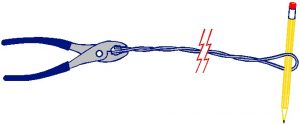
One strand of this wire is too flimsy, but doubling and twisting a double strand is perfect. Start with a 24" (2 foot) piece and fold it in half. Holding the two ends with pliers, twist the wires together with a pencil or pen. The red lines indicate a break--only in the picture. It was getting too long to show the whole wire on the page. - Electrical wire: By this I mean the stiff, solid wire used inside the walls of houses not the flexible stuff used for appliance cords. If you know an electrician, ask if they have any scrap "Romex," any gauge. From that you can cut out three pieces of wire (black, white and bare). Use the bare one first, or strip off the last two inches of insulation where the propeller will spin. You need about a 12" piece.

- Electric fence wire: I happen to have a roll lying around. Even doing this project with hundreds of kids a year, I've got a lifetime supply.
- Cardboard: I use cereal boxes to help make people aware of how much stuff we waste, but poster board works.
- Scissors, pencil or pen
- Paper-punch The paper punch is convenient and it leaves a clean edge that works well on the propeller stick. You can punch the hole in the propeller with a pencil or pen.
- Pliers Pliers help bend stubborn wire.
Step 1. Bend the wire

- It does not have to look exactly like the example. It should have a couple of gentle bends in the middle. Use pliers if needed.

- It should have some sort of handle on the back end that allows you to get a firm grip so the wire doesn't twist in your hand. It should have a couple of inches straight on the front end where the propeller has room to spin.

- If you are using thin wire that you doubled up and twisted, make the loop the front and the two ends the handle end. The loop will keep the propeller from falling off.
- Make a propeller that's about an inch wide and about three inches long. Try to get the hole as close to the middle as possible. A simple and accurate way to locate the center of a rectangle is to draw a straight lines from corner to corner.
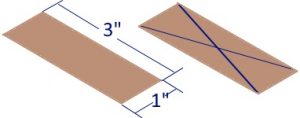
-
- If you have hole punch, use it to make the hole in the center of the propeller. Skip the next two paragraphs to the next step.

If you don't have a hole punch, you can punch through the cardboard with a pen or a pencil. Put a washcloth or sock or something on the table and the propeller on top so you punch into the soft stuff.
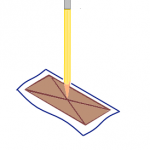
The cardboard that was where the hole is now--but is now pushed out around the edge--can get in the way of the spinning. Use your thumbnail or fingernail to fold those tiny bits of cardboard outward so they lie down flat against the propeller. They will spring back up somewhat. That's OK.
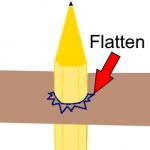
Step 3
Make a stop to hold the spinning propeller on.
Skip this step if you made your propeller stick out of thin wire that you twisted because the loop at the front end will keep your propeller on. For everybody else, if you wrap several inches of tape around the front end, not only will it help keep the propeller on, it can also blunt the sharp wire end.
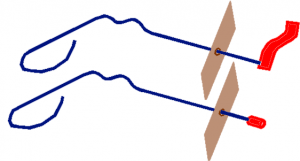
Step 4. Try it!
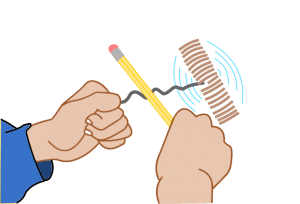 If you are right-handed, hold a pen or pencil in that hand. Hold the pencil--not horizontally and not vertically--but at about a 45 degree angle. Grip the propeller in the other hand. Push the pen to the bumps firmly and rub. Once you "get it" it will be easy to get the propeller to spin furiously, but allow a few minutes this first time. Experiment. Rub fast, rub slow, hard, soft, vary the angle of your pencil.
If you are right-handed, hold a pen or pencil in that hand. Hold the pencil--not horizontally and not vertically--but at about a 45 degree angle. Grip the propeller in the other hand. Push the pen to the bumps firmly and rub. Once you "get it" it will be easy to get the propeller to spin furiously, but allow a few minutes this first time. Experiment. Rub fast, rub slow, hard, soft, vary the angle of your pencil. - If you have hole punch, use it to make the hole in the center of the propeller. Skip the next two paragraphs to the next step.
I'd like to know how this project goes for you. I'm happy to answer questions about it. Feedback from you is an important way for me to know what works and what needs clarification.
